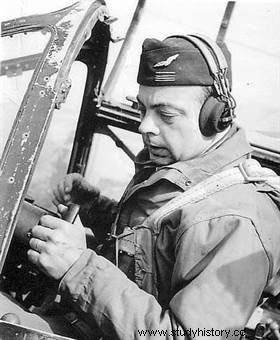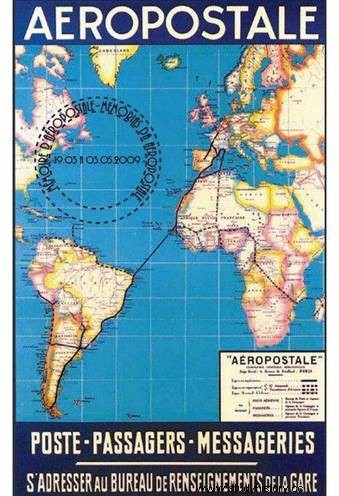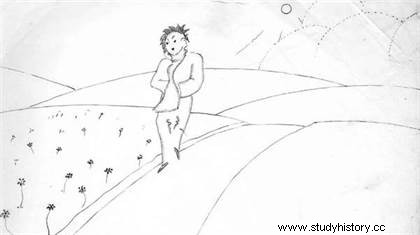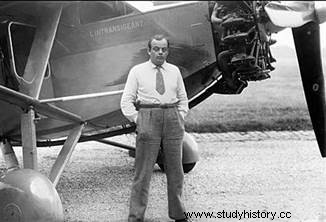 Antoine de Saint-Exupéry (1900-1944) was a pioneer of civil aviation. Endowed with literary talent, he recounted his experiences in several works (Courrier Sud, Vol de nuit, Terres des hommes) in which he expressed his humanism and his ideal of greatness and solidarity among men. Endowed with a poetic sense, he is the author of one of the most famous works in the world, The Little Prince, published in 1943. He died mysteriously during an air mission in 1944.
Antoine de Saint-Exupéry (1900-1944) was a pioneer of civil aviation. Endowed with literary talent, he recounted his experiences in several works (Courrier Sud, Vol de nuit, Terres des hommes) in which he expressed his humanism and his ideal of greatness and solidarity among men. Endowed with a poetic sense, he is the author of one of the most famous works in the world, The Little Prince, published in 1943. He died mysteriously during an air mission in 1944.
Antoine de Saint-Exupéry, dreamy aristocrat and pilot
Born June 29, 1900 in Lyon, Antoine de Saint-Exupéry has aristocratic origins and received a careful classical education. His mother, although widowed prematurely (Antoine's father died in 1904), raised her five children with remarkable devotion and enthusiasm. Within the Antoine siblings, a curious and sensitive child, he quickly stood out for his intellectual vivacity. One day in 1912, in Ain, he discovered what was to become his great passion:aviation. Having befriended the mechanics of the aerodrome of Ambérieu in Bugey, he made his first flight at 12 years old! The experience inspired him to write the first of a long series of poems devoted to the intoxication of flight.
A relatively undisciplined and often mediocre student, Saint-Exupéry nonetheless shined with his literary talent, which enabled him to obtain the baccalaureate in 1917, but not to consider the future with serenity. His military service (where he took piloting lessons on his own initiative as an aviation mechanic) confirmed him in his passion for aeronautics. Yet he leaves the memory of a dreamy and distracted aviator, more famous for his poems and his wacky drawings than for his aerobatic exploits. However in 1925 he was hired by the Latécoère company to carry out mail transport flights. The myth of the airmail is about to take off...
Aeropostale
 His beginnings as a commercial pilot gave Saint-Exupéry the opportunity to publish his first book:The Aviator . They also allow him to bond with a certain Jean Mermoz. Having become stopover manager at Cap Juby in Morocco (Latécoère operates a Toulouse-Dakar line, with many stopovers), he had his first exotic adventures when, after a forced landing, he only owed his survival in the desert to the help of Trappist monks. An experience he recounted in his famous Courrier Sud .
His beginnings as a commercial pilot gave Saint-Exupéry the opportunity to publish his first book:The Aviator . They also allow him to bond with a certain Jean Mermoz. Having become stopover manager at Cap Juby in Morocco (Latécoère operates a Toulouse-Dakar line, with many stopovers), he had his first exotic adventures when, after a forced landing, he only owed his survival in the desert to the help of Trappist monks. An experience he recounted in his famous Courrier Sud .
The founding of Compagnie Générale Aéropostale in 1927 opened up new horizons for aviation pioneers. This time, it is no longer a question of linking Europe to Africa but of crossing the Atlantic to deliver mail to South America. This is a strategic issue for the development of commercial aviation, but above all a formidable technical and human challenge. Saint-Exupéry is enthusiastic about this project and will join Mermoz in South America, in particular to develop the lines towards this end of the world which is Patagonia.
This Argentinian experience will earn him the birth of his novel Vol de Nuit (1931), which will be a huge success. Unprecedented commercial and human adventure, the airmail will however be overtaken by the financial (and political) reality and dark between 1931 and 1933 to be reborn within the framework of Air France. Saint-Exupéry, who was not very enthusiastic about this development, then tried his hand at a career as a great reporter. The latter allows him to reconcile his two passions of flying and writing. He will notably be sent to Spain to cover the civil war there. This stay will inspire him Terres des Hommes, which will earn him the grand prize of the novel of the French Academy in 1939.
The Little Prince and the war pilot
When the Second World War broke out, the famous writer was mobilized as an airman in a reconnaissance group (the famous 2/33). Although considered by the air force command as unsuitable for combat missions, he nevertheless accomplished his task with courage. Thus his reconnaissance missions over Germany and Arras (when the city was taken by the Germans) earned him the Croix de Guerre. It was during this first phase of the war that Saint-Ex laid down the first lines of what was to become his masterpiece:the Little Prince (which would appear in 1943).
 Demobilized in August 1940, Antoine de Saint-Exupéry went to the United States like many French artists. His ambiguous attitude towards Vichy (which is no different from that of many French people) does not prevent him from putting his celebrity to the benefit of the cause of an entry into the war of the United States against the Third Reich. He nevertheless fears a fratricidal confrontation between French, which earned him the mistrust of the Free French. From 1941 to 1943, he stayed in New York, using his notoriety to plead the cause of the French resistance to the Americans.
Demobilized in August 1940, Antoine de Saint-Exupéry went to the United States like many French artists. His ambiguous attitude towards Vichy (which is no different from that of many French people) does not prevent him from putting his celebrity to the benefit of the cause of an entry into the war of the United States against the Third Reich. He nevertheless fears a fratricidal confrontation between French, which earned him the mistrust of the Free French. From 1941 to 1943, he stayed in New York, using his notoriety to plead the cause of the French resistance to the Americans.
In 1943 after North Africa fell into the Allied camp (following Operation Torch) he joined Tunisia to resume service. The military authorities are completely skeptical about the abilities of this whimsical writer, in fragile health and reputed to be depressed. Nevertheless, thanks to his many connections and his stubbornness, Saint-Ex ends up being reinstated within the famous 2/33. His first missions since 1940 were punctuated by incidents (technical but not only) which foreshadowed the worst.
The mystery of the death of Antoine de Saint-Exupéry
July 31, 1944, Corsica. At the controls of his twin-engine P-38 Lightning, Commander Antoine de Saint-Exupéry takes off at 8:45 a.m. from Poretta airport near Borgo. The famous aviator, who has not been in top form for a long time, must carry out a photographic reconnaissance mission above Dauphiné and Savoie. The Allied command was then in the midst of preparing for the landing in Provence and such missions proved to be invaluable. What was only supposed to be a routine flight, however, will cost the life of Antoine de Saint-Exupéry. Somewhere off the coast of Provence, his P-38 plane crashes into the sea. One of the most emblematic careers of 20th century French literature has just come to an abrupt end...
 What happened on July 31, 1944? The mystery remains. It was first claimed for a long time that he had been shot down over Castellane by an Fw-190. This theory was undermined in 2000, when significant debris from his device was found (which can also be discovered at the Musée du Bourget) off the coast of Marseille. Was it more of a suicide? Or was he the victim of this Me-109 pilot:Horst Rippert (who became a sports journalist after the war) who claimed in Provence in 2008 to have shot down, to his greatest regret, one of his favorite writers.
What happened on July 31, 1944? The mystery remains. It was first claimed for a long time that he had been shot down over Castellane by an Fw-190. This theory was undermined in 2000, when significant debris from his device was found (which can also be discovered at the Musée du Bourget) off the coast of Marseille. Was it more of a suicide? Or was he the victim of this Me-109 pilot:Horst Rippert (who became a sports journalist after the war) who claimed in Provence in 2008 to have shot down, to his greatest regret, one of his favorite writers.
We'll probably never know what happened that day. This certainly contributed to the popularity of this writer, a solitary pilot often lost in the foreign skies of his imagination...
Bibliography
- Antoine de Saint-Exupéry, biography of Alain Vircondelet. Bibliography Julliard, 1994.
- Antoine de Saint Exupéry:The Oasis to Conquer, by Thomas Fraisse. Transboreal, 2014.
